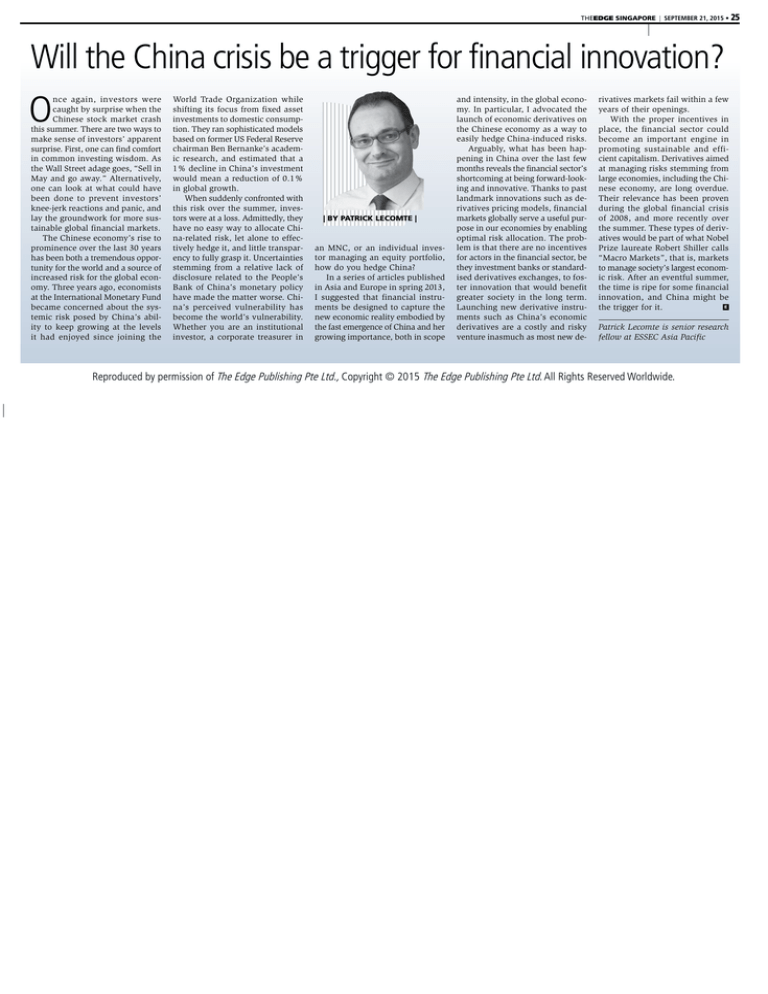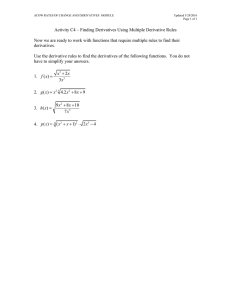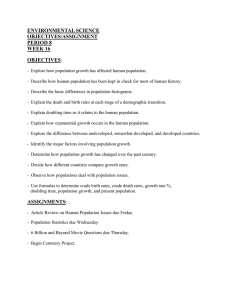
THEEDGE SINGAPORE | SEPTEMBER 21, 2015 • 25
Will the China crisis be a trigger for financial innovation?
OPINION
Crude convulses amid economic uncertainties
O
and intensity, in the global econo- rivatives markets fail within a few
nce again, investors were World Trade Organization while
my. In particular, I advocated the years of their openings.
caught by surprise when the shifting its focus from fixed asset
launch of economic derivatives on
Chinese stock market crash investments to domestic consumpWith the proper incentives in
the(Opec),
Chinese
tion. They
ran sophisticated
models
tries
theeconomy
US as wellasasa way to
this summer.
are two
ways to
the
could
Platts
China Oil Analytics.
ugust There
delivered
a painful
reminder
Opecplace,
ramped
upfinancial
its supplysector
to a near
threeeasily
China-induced
based on former
Federal
Russia
— hedge
collectively
account- risks.
make sense
investors’
become
important
engine
The US
market
is Reserve
not oblivious
to theofoil
markets apparent
that with supply
year high
of 31.4anmillion
bpd in
July, in
with
what
has
been Saudi
hap- Arabia
Bernanke’s
academ-growth
ing forArguably,
about 53%
of the
globsurprise.
First,
one can
comfort
promoting
sustainable
effithe pockets
of demand
and
demand
stillfind
a long
way off chairman
from to Ben
at 10.45
million bpdand
accounting
pening
China over
the lastfor
few
ic research,
and
that a
al total
— in
continues
to grow
in common
investing
wisdom.
Asprone
cient
Derivatives
aimedto a
theestimated
globe, prominently
in
rebalancing,
prices
remain
to across
almost
allcapitalism.
of the increase,
according
months
reveals continue
the financial
1% decline
in and
China’s
and
inventories
to sector’s
the Wallbeing
Street
adage goes,
at managing risks stemming from
China
the investment
US, but it is also
whipsawed
by“Sell
fear in
and specPlatts survey.
shortcoming
being forward-looka reduction
0.1%
swell,
from theatOrganisation
May and
away.”along
Alternatively,
large economies,
including the
painfully
aware ofofthe
gulf beulation,
and go
dragged
for the ride would
with mean
The latest
round of bloodletting
in Chithe oil
and innovative.
Thanks tomarkets
past nese
growth.
foring
Economic
Co-operation
one can
look atsentiment.
what could have in globaltween
economy,
are long
overdue.
incremental consumption
volatile
economic
and fears
of prices
testing
new lows
landmark
innovations
such asindeWhenand
suddenly
confronted
with this
and
Development
countries
been
to prevent
Their relevance
has been
proven rethe rising
tide of supply
Fresh done
reminders
of the investors’
global glut — the
the coming
months have
predictably
rivativesstorage
pricinginmodels,
this riskyear
overand
the the
summer,
inves-barrels
to floating
Iran andfinancial
knee-jerk reactions
panic,
and pegged
during
the global
financial
crisis readditional
International
Energy and
Agency
(IEA)
newed the
question
whether
Opec might
serve
a usefulverse
pur- itsofstrategy
at a loss. from
Admittedly,
they
themarkets
strategicglobally
petroleum
reserve
lay the groundwork
for moremismatch
sus- torsatwereexpected
2008, and
more
recently
over in
a post-sanctions
| BY PATRICK LECOMTE |
second-quarter
supply-demand
and cut
output,
possibly
in our economies by enabling
havea noIran
easyinway
to allocate Chiin pose
China.
tainable
global
financial
the summer.
These
types
of deriv2016.
three
million
barrels
per daymarkets.
(bpd) — and
cooperation
with some
of the
major
producoptimal
allocation.
The probrisk, IEA
let alone
effec-report
The US risk
Energy
InformaThe Chinese
economy’s
to na-related
atives
The
in its to
August
worsening
outlook for
China’s rise
economy
with
ers outside
thewould
group.be part of what Nobel
lem
is that there are
nothe
incentives
or an individual
it, and
Administration
says
overeffects
the lastin30
years
laureate
Shiller
calls
pegged
this little
year’stransparoversupplyan
at MNC,
its prominence
potential ripple
the
regiontively
and hedge
The Prize
fact that
signsRobert
of strain
are evident
| BY VANDANA
HARI | inves- tion
for actors
in the financial
sector,
be the
tor managing an equity portfolio, country’s
grasp it.
producers
are cuthas been
both
a tremendous
oppor- ency
“Macro
Markets”,
thatand
is, markets
an average
1.1Uncertainties
million bpd, saying
beyond
drove
global
crude benchmarks
to to fully
across
producing
nations
most Opec
they investment
banks
or standarddo you
hedgeting
China?
from a relative
of how
output in response
to the recent
slump
tunity lows. for the world and a source of stemming
to are
manage
society’s
economit expected
demandlack
to increase
by 1.6
million
6½-year
producers
running
fiscallargest
deficits,
with Sauised
exchanges,
In a in
series
of articles
published
disclosure
to thetoPeople’s
in prices.
It reported
9.3derivatives
million bpd
average todifosincreased
for the global
ic risk.
After
eventful
summer,
bpdrelated
(in contrast
just 700,000bpd
2014)
On Aug 24,risk
front-month
Brenteconfutures plumArabia’s
being
thean
largest,
lends
credence
ter innovation
that would
in Asia
in spring
Bank ofand
China’s
monetary
for2013,
June, down
from 9.4 million
bpd benefit
omy.6%
Three
years ago,
economists
the time isthat
ripeOpec
for some
supply
to rise bypolicy
2.7 million
bpd.and Europeoutput
meted
in a single
day to
close at US$42.69
to the argument
mightfinancial
or should
greater society
in 9.6
themillong term.
suggested
that financial
instruhave madeWhat
the matter
worse.price
Chi-routI tells
in May, and
the year-to-date
high of
at thewhile
International
Monetary
innovation, and China might be
the August
us is that
a barrel,
Nymex light
sweet Fund
crude slipped
change tack.
E
Launching
be about
designedlion
to capture
the But
na’s
vulnerability
bpd in April.
the June new
figurederivative
was still instrubecame
concerned
about the
sys- by
the
trigger
for it. seems remote. Opec
market participants
are has
far lessments
sanguine
5.5%
to US$38.24
a barrel,
spooked
an perceived
So far,
that
possibility
ments
such as China’s economic
newface
economic
by a year
becomethe
the demand
world’s growth
vulnerability.
7%embodied
higher than
ago.
temic
risk in
posed
by China’s
story in the
of eco-reality
8.5%
plunge
China’s
ShanghaiabilComposite
might decide to wait out a bit longer. That
derivatives
a costly
and risky
the fast
and her
Whethernomic
you are
an institutional
In Russia,
where the
rouble hasare
almost
halved
ity to
keepsent
growing
the levels
Lecomte
senior research
headwinds,
including those
in emergence
Europe. of China
Index,
which
shockat
waves
across equity
won’t bePatrick
because
of any is
consensus
for doing
venture
inasmuch
scope
a corporateoftreasurer
in growing
valueinfrom
a year
ago against
the as
USmost
dol-new
it hadworldwide. enjoyed since joining the investor,Expectations
at ESSEC Asia
supply overhang
now importance,
extend in both
markets
sodewithinfellow
the organisation,
butPacific
simply because
Crude ticked up in fits and starts in the fol- beyond 2016, and Nymex crude is below the lar and helped offset the oil price collapse for the Saudis might be able to prevail again at the
lowing days, but Brent still closed the month US$55 mark on the forward curve through producers, crude and condensate output rose December meeting with the argument that it
2% on year to 10.68 million bpd in August, is a question of market share and this battle
20% below its year-to-date high of US$67.77. end-2016. with
exports
non-CIS
(Commonwealth
theEdge
meantime,
production
fromCopyright
the Or- ©
Alarm bells were
already ringing
on Beiis going
to take Worldwide.
time to win. Russia has made
Reproduced
by permission
ofIn
The
Publishing
Pte Ltd.,
2015
The toEdge
Publishing
Pte Ltd. Allof Rights
Reserved
jing’s move on Aug 11 to devalue the renminbi ganization of the Petroleum Exporting Coun- Independent States) countries jumping 11%. all the right noises, but doesn’t appear in the
and the subsequent government interventions
least bit inclined to cut, either.
to manage the currency’s descent while trying
A handful of small US shale producers have
ICE Brent and Nymex light sweet
to contain the domestic stock market rout at
already gone bankrupt this year. A confluence
the same time. Poor economic data, showing
of factors, including Nymex crude languishing
US$ a barrel
70
more pronounced contraction in manufacturin the US$40s, flow of funds to some of the
ing activity and a slump in Chinese exports,
weaker independents becoming difficult and
65
reinforced a more pessimistic prognosis for the
the producers entering 2016 far less hedged
world’s second-largest economy.
than 2015, might just bring about a sharper
60
While China’s crude imports in the first sevdownturn in US output in the coming months
en months of the year grew by a healthy 10%
than currently anticipated.
55
and refinery throughput was 4.7% higher than
The question then is to what extent the re50
in the corresponding period of 2014, its stockmoval of even a few hundred thousand barpiles of crude as well as products have been
rels from daily supply would prop up oil pric45
rising, suggesting much lower rise in end-uses. And, more importantly, what impact would
er consumption.
that price recovery have on US production. E
40
China is expected to continue ratcheting up
ICE Brent
Nymex light sweet
its crude imports between 2015 and 2020 at an
Vandana Hari (vandana@platts.com) is Asia
35
average rate of about 5.5%, importing rougheditorial director at Platts, a global energy, pet30
ly 210,000bpd for stockpiling over this perirochemicals, metals and agriculture informaJanuary
February
March
April
May
June
July
August 2015
od, while its oil demand grows at just around
tion provider and a division of McGraw Hill
3.6% annually, according to a recent report by
Financial
INTERCONTINENTAL EXCHANGE
A
Will the China crisis be a trigger for financial innovation?
O
nce again, investors were
caught by surprise when the
Chinese stock market crash
this summer. There are two ways to
make sense of investors’ apparent
surprise. First, one can find comfort
in common investing wisdom. As
the Wall Street adage goes, “Sell in
May and go away.” Alternatively,
one can look at what could have
been done to prevent investors’
knee-jerk reactions and panic, and
lay the groundwork for more sustainable global financial markets.
The Chinese economy’s rise to
prominence over the last 30 years
has been both a tremendous opportunity for the world and a source of
increased risk for the global economy. Three years ago, economists
at the International Monetary Fund
became concerned about the systemic risk posed by China’s ability to keep growing at the levels
it had enjoyed since joining the
World Trade Organization while
shifting its focus from fixed asset
investments to domestic consumption. They ran sophisticated models
based on former US Federal Reserve
chairman Ben Bernanke’s academic research, and estimated that a
1% decline in China’s investment
would mean a reduction of 0.1%
in global growth.
When suddenly confronted with
this risk over the summer, investors were at a loss. Admittedly, they
have no easy way to allocate China-related risk, let alone to effectively hedge it, and little transparency to fully grasp it. Uncertainties
stemming from a relative lack of
disclosure related to the People’s
Bank of China’s monetary policy
have made the matter worse. China’s perceived vulnerability has
become the world’s vulnerability.
Whether you are an institutional
investor, a corporate treasurer in
| BY PATRICK LECOMTE |
an MNC, or an individual investor managing an equity portfolio,
how do you hedge China?
In a series of articles published
in Asia and Europe in spring 2013,
I suggested that financial instruments be designed to capture the
new economic reality embodied by
the fast emergence of China and her
growing importance, both in scope
and intensity, in the global economy. In particular, I advocated the
launch of economic derivatives on
the Chinese economy as a way to
easily hedge China-induced risks.
Arguably, what has been happening in China over the last few
months reveals the financial sector’s
shortcoming at being forward-looking and innovative. Thanks to past
landmark innovations such as derivatives pricing models, financial
markets globally serve a useful purpose in our economies by enabling
optimal risk allocation. The problem is that there are no incentives
for actors in the financial sector, be
they investment banks or standardised derivatives exchanges, to foster innovation that would benefit
greater society in the long term.
Launching new derivative instruments such as China’s economic
derivatives are a costly and risky
venture inasmuch as most new de-
rivatives markets fail within a few
years of their openings.
With the proper incentives in
place, the financial sector could
become an important engine in
promoting sustainable and efficient capitalism. Derivatives aimed
at managing risks stemming from
large economies, including the Chinese economy, are long overdue.
Their relevance has been proven
during the global financial crisis
of 2008, and more recently over
the summer. These types of derivatives would be part of what Nobel
Prize laureate Robert Shiller calls
“Macro Markets”, that is, markets
to manage society’s largest economic risk. After an eventful summer,
the time is ripe for some financial
innovation, and China might be
E
the trigger for it.
Patrick Lecomte is senior research
fellow at ESSEC Asia Pacific




